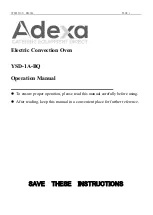
10
Cooking Instructions
Cooking Utensils
Recommended Use
•
Glass and glass-ceramic bowls and dishes
— Use for heating or cooking.
•
Microwavable browning dish
— Use to brown the exterior of small items such
as steaks, chops, or pancakes. Follow the directions provided with your browning
dish.
•
Microwavable plastic wrap
— Use to retain steam. Leave a small opening for
some steam to escape and avoid placing it directly on the food.
•
Wax paper
— Use as a cover to prevent spattering.
•
Paper towels and napkins
— Use for short-term heating and covering; they
absorb excess moisture and prevent spattering. Do not use recycled paper towels,
which may contain metal and can catch fire.
•
Paper plates and cups
— Use for short-term heating at low temperatures. Do
not use recycled paper, which may contain metal and can catch fire.
•
Thermometers
— Use only those labeled “Microwave Safe” and follow all
directions. Check the food in several places. Conventional thermometers may be
used once the food has been removed from the oven.
Limited Use
•
Aluminum foil
— Use narrow strips of foil to prevent overcooking of exposed
areas. Using too much foil can damage your oven, so be careful.
•
Ceramic, porcelain, and stoneware
— Use these if they are labeled
“Microwave Safe”. If they are not labeled, test them to make sure they can be used
safely. Never use dishes with metallic trim.
•
Plastic
— Use only if labeled “Microwave Safe”. Other plastics can melt.
•
Straw, wicker, and wood
— Use only for short-term heating, as they can be
flammable.
Not Recommended
•
Glass jars and bottles
— Regular glass is too thin to be used in a microwave,
and can shatter.
•
Paper bags
— These are a fire hazard, except for popcorn bags that are
designed for microwave use.
•
Styrofoam plates and cups
— These can melt and leave an unhealthy residue
on food.
•
Plastic storage and food containers
— Containers such as margarine tubs
can melt in the microwave.
Metal utensils
— These can damage your oven. Remove all metal before
cooking.
Testing Utensils
If you are not sure whether a dish is microwave-safe or not, you can perform this test:
1.
Fill a 1 cup glass measuring cup with water and put it inside your oven, next to the
dish you want to test.
2.
Press the
One
button once to heat them for one minute at High power.
The water should be warm and the dish you are testing should be cool. If the dish
is warm, then it is absorbing microwave energy and is not acceptable for use in the
microwave.
Cooking Techniques
Stirring
Stir foods such as casseroles and vegetables while cooking to distribute heat evenly.
Food at the outside of the dish absorbs more energy and heats more quickly, so stir
from the outside to the center. The oven will turn off when you open the door to stir your
food.
Arrangement
Arrange unevenly shaped foods, such as chicken pieces or chops, with the thicker,
meatier parts toward the outside of the turntable where they receive more microwave
energy. To prevent overcooking, place thin or delicate parts toward the center of the
turntable.
Shielding
Shield food with narrow strips of aluminum foil to prevent overcooking. Areas that need
shielding include poultry wing-tips, the ends of poultry legs, and corners of square bak-
ing dishes. Use only small amounts of aluminum foil. Larger amounts can damage your
oven.
Turning
Turn foods over midway through cooking to expose all parts to microwave energy. This
is especially important with large items such as roasts.
Standing
Foods cooked in the microwave build up internal heat and continue to cook for a few
minutes after the oven stops. Let foods stand to complete cooking, especially foods
such as roasts and whole vegetables. Roasts need this time to complete cooking in the
center without overcooking the outer areas. All liquids, such as soup or hot chocolate,
should be shaken or stirred when cooking is complete. Let liquids stand a moment
before serving. When heating baby food, stir well and test the temperature before serv-
ing.
Adding Moisture
Microwave energy is attracted to water molecules. Food that is uneven in moisture con-
tent should be covered or allowed to stand so that the heat disperses evenly. Add a
small amount of water to dry food to help it cook.
General Tips
•
Dense foods, such as potatoes, take longer to heat than lighter foods. Foods with
a delicate texture should be heated at a low power level to avoid becoming tough.
•
Altitude and the type of cookware you are using can affect cooking time. When
using a new recipe, use the minimum cooking time and check the food
occasionally to prevent overcooking.
•
Foods with a non-porous skin such as potatoes or hot dogs, should be pierced to
prevent bursting.
•
Frying with heating oil or fat is not recommended. Fat and oil can suddenly boil
over and cause severe burns.
•
Some ingredients heat faster than others. For example, the jelly inside a jelly
doughnut will be hotter than the dough. Keep this in mind to avoid burns.
•
Home canning in the microwave oven is not recommended because all harmful
bacteria may not be destroyed by the microwave heating process.
•
Although microwaves do not heat the cookware, the heat from the food is often
transferred to the cookware. Always use pot holders when removing food from the
microwave and instruct children to do the same.
•
Making candy in the microwave is not recommended as candy can heat to very
high temperatures. Keep this in mind to avoid injury.
MS123SCE_GB.fm Page 10 Wednesday, November 24, 2004 9:04 AM


































